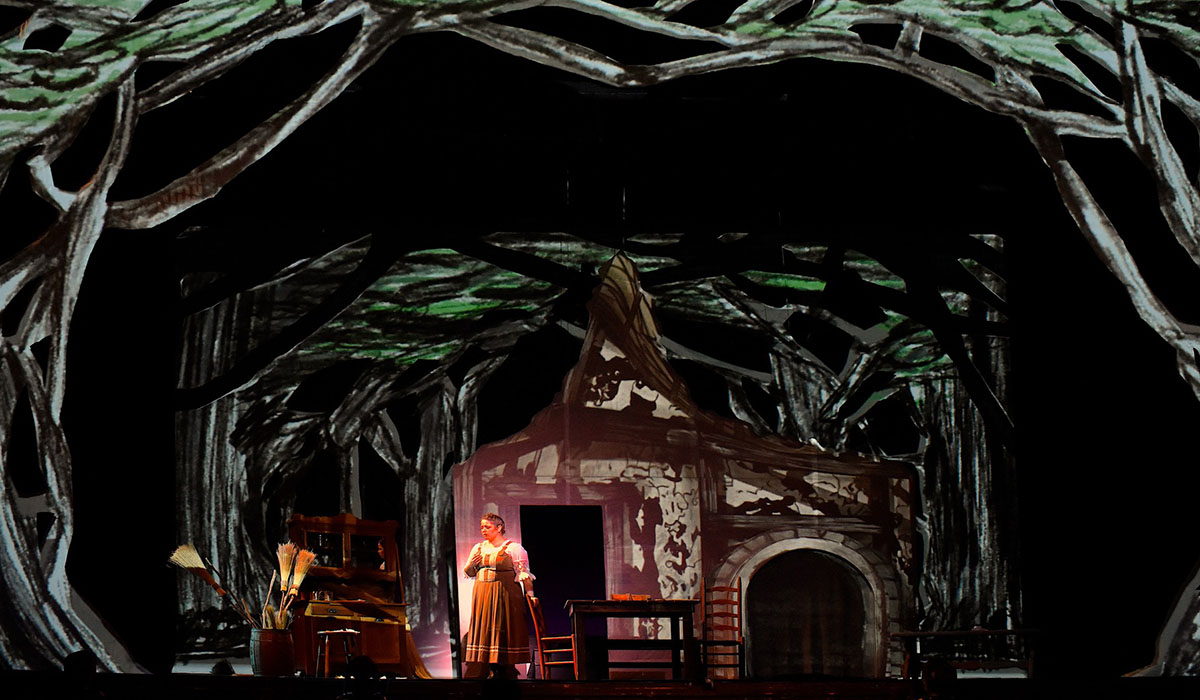It felt like it had been forever since the University of Tennessee Opera Theatre had trod the boards at the Bijou Theatre—but the company was back last weekend with a production of Engelbert Humperdinck’s Hänsel und Gretel, an operatic telling of the Brothers Grimm fairytale. In fact, it had only been a year-and-a-half since UTOT staged The Magic Flute in the Bijou in November 2021, but a year-and-a-half in the life of a student singer is—for all intents and purposes—almost forever. In that time, a scheduling conflict at the Bijou forced a Plan B staging of Die Fledermaus at the Tennessee Amphitheater in World’s Fair Park. But, that Plan B turned to Plan C when inclement weather forced the production into the UT Band Room in the Natalie Haslam Music Center. And, last fall found UTOT working in cahoots with Knoxville Opera’s production of The Merry Widow at the Tennessee Theatre—a production in which UTOT members took secondary and cover roles.
Back at the Bijou, UTOT stage director James Marvel was once again in his preferred environment, creating a vivid and energetic production of four performances of Hänsel und Gretel split up with a double cast. Marvel called on designers Katie Stepanek and DJ Pike for the combination of shaped surfaces and video projections which created the ever-varying and immersive stage environment, from humble cottage to deep, dark forest, to the witch’s seductively colorful gingerbread house. Lighting designer John Horner added some delicious layers of color saturation, balancing light and shadow to the projections with precision. Marvel also incorporated a really neat effect into the opera’s climax: the use of hand-out audience glasses that created a gingerbread figure in points of light.

As mentioned, the double casting produced alternating performances of two slates of singers, each reasonably matched in terms of acting and vocal strength. [Unfortunately, I could not attend the Friday evening performance in which Mikaela McQueston also sang the role of Gretel.] The role of Hansel is typically sung by a mezzo-soprano with Gretel being a light soprano role.
The Saturday afternoon cast featured Emma Wilson as Hansel and Elena Klein as sister Gretel, both making a noteworthy major role debut with UTOT, I believe. Challenged by the rigors of parenting and the village broom trade, their Father was sung by a robust and energetic James JJ Robinson who was paired with Jessica Parker as Mother. Parker brought a nice level of pathos and exasperation to the role.

The Saturday evening cast featured Staley Clark and Madison Mackey as Hansel and Gretel respectively. The pair created a rather nice sympathetic synergy with their characters. Baritone James Hooper Stevens brought a visually commanding comic strength and a rich vocal character to Father. Tori Patricia Franklin was a strong and resilient Mother, vocally and dramatically.

Enter the Witch, a role that can be done traditionally by a mezzo-soprano in traditional witch garb with traditional witch movements. However, those that have seen a number of director Marvel’s productions, though, know full well that “traditional” has been replaced by “over the top” in his UTOT staging vocabulary. With a costume design by Patti Lynn Rogers, his Witch in this production makes a grand entrance, clad in a flowing candy-striped overskirt, gloves, and shoulder pad spikes, complete with a platinum-blond wig—and, of course, sung by males. Admittedly, with the role intended for a lower woman’s voice, this can present vocal issues in that it places the male voices in a range in which it is difficult to project. Jackson Guthrie as the Witch in the Saturday afternoon cast made it work for him. Shaquille St. John in the evening cast had a bit more trouble being heard over the orchestra.
Stunningly costumed, the role of the Dew Fairy was sung by Hannah Cipriana, Vivian Hirst, and Evelyn Spencer. The Sandman was sung by Claudia DellaSantina and Isabella Nicoli.
The pit orchestra—performing four performances in three days—was the UT Opera Orchestra under conductor Kevin Class. Special kudos here go to the horns (James Roddy and Nichole Hollenbeck) and bassoon (James Carnal) for the beautifully rendered introduction to Children’s Prayer opening theme in the overture that starts it all in motion.







